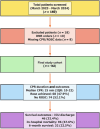Cardiopulmonary resuscitation duration and patient survival in a South Indian intensive care unit
- PMID: 40880553
- PMCID: PMC12305047
- DOI: 10.5492/wjccm.v14.i3.105611
Cardiopulmonary resuscitation duration and patient survival in a South Indian intensive care unit
Abstract
Background: Return of spontaneous circulation (ROSC) following cardiopulmonary resuscitation (CPR) is a critical determinant of survival in patients experiencing cardiac arrest. This study aimed to investigate the relationship between the duration of CPR, the achievement of ROSC, and both short-term [intensive care unit (ICU) and in-hospital] and long-term survival outcomes in patients admitted to the medical intensive care unit (MICU) of Dr. Moopen's Medical College Hospital, Wayanad, Kerala, India.
Aim: To assess how cardiopulmonary resuscitation duration impacts short-term and long-term survival in cardiac arrest patients in intensive care.
Methods: A retrospective observational cohort study was conducted on adult patients who received CPR in the MICU between March 2023 and March 2024. Data were extracted from electronic medical records, including demographics, duration of CPR, ROSC achievement, and survival outcomes. Short-term survival was defined as survival to ICU discharge and in-hospital mortality, while long-term survival was assessed at six months post-arrest. Statistical analysis was performed using SPSS software, with Kaplan-Meier survival analysis and Cox regression used to identify predictors of mortality.
Results: A total of 142 patients were included in the study. The median duration of CPR was 15 minutes. ROSC was achieved in 68 patients (47.9%). A significant association was observed between the duration of CPR and ROSC achievement (P < 0.001). Patients who achieved ROSC early had significantly higher rates of short-term and long-term survival compared to those who did not (P < 0.001). Each additional minute of CPR was associated with a 7% decrease in the odds of achieving ROSC. Longer CPR duration (HR: 1.05, 95%CI: 1.02-1.08), absence of ROSC (HR: 4.87, 95%CI: 2.31-10.28), older age (HR: 1.03, 95%CI: 1.01-1.06) and unwitnessed arrest (HR: 1.89, 95%CI: 1.05-3.41) were independent predictors of mortality.
Conclusion: Timely, effective cardiopulmonary resuscitation improves survival in intensive care. Duration significantly predicts return of circulation and outcomes. Further research should explore factors affecting resuscitation length and optimize treatment strategies.
Keywords: Cardiac arrest; Cardiopulmonary resuscitation; Critical care; India; Intensive care unit; Return of spontaneous circulation; Survival.
©The Author(s) 2025. Published by Baishideng Publishing Group Inc. All rights reserved.
Conflict of interest statement
Conflict-of-interest statement: All authors declare that they have no competing interests.
Figures






References
-
- Gräsner JT, Lefering R, Koster RW, Masterson S, Böttiger BW, Herlitz J, Wnent J, Tjelmeland IB, Ortiz FR, Maurer H, Baubin M, Mols P, Hadžibegović I, Ioannides M, Škulec R, Wissenberg M, Salo A, Hubert H, Nikolaou NI, Lóczi G, Svavarsdóttir H, Semeraro F, Wright PJ, Clarens C, Pijls R, Cebula G, Correia VG, Cimpoesu D, Raffay V, Trenkler S, Markota A, Strömsöe A, Burkart R, Perkins GD, Bossaert LL EuReCa ONE Collaborators. EuReCa ONE-27 Nations, ONE Europe, ONE Registry: A prospective one month analysis of out-of-hospital cardiac arrest outcomes in 27 countries in Europe. Resuscitation. 2016;105:188–195. - PubMed
-
- Correction to: Heart Disease and Stroke Statistics-2018 Update: A Report From the American Heart Association. Circulation. 2018;137:e493. - PubMed
-
- Merchant RM, Yang L, Becker LB, Berg RA, Nadkarni V, Nichol G, Carr BG, Mitra N, Bradley SM, Abella BS, Groeneveld PW American Heart Association Get With The Guidelines-Resuscitation Investigators. Incidence of treated cardiac arrest in hospitalized patients in the United States. Crit Care Med. 2011;39:2401–2406. - PMC - PubMed
-
- Nolan JP, Soar J, Zideman DA, Biarent D, Bossaert LL, Deakin C, Koster RW, Wyllie J, Böttiger B ERC Guidelines Writing Group. European Resuscitation Council Guidelines for Resuscitation 2010 Section 1. Executive summary. Resuscitation. 2010;81:1219–1276. - PubMed
LinkOut - more resources
Full Text Sources

